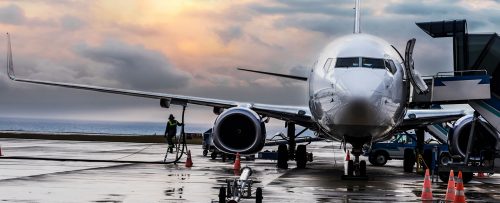
United Airlines Talks Sustainability
An Interview with United’s Chief Sustainability Officer Lauren Riley
SIGN UP FOR RMI’S CORPORATE NEWSLETTER
Aviation contributes to the carbon footprint of nearly every global business, and accounts for around 3 percent of global carbon emissions. Yet as one of the hardest-to-abate sectors of the economy, and one still reeling from the COVID-19 pandemic, aviation’s path to net-zero carbon emissions faces technological and financial hurdles for companies looking to decarbonize.
Despite this, United Airlines Chief Sustainability Officer Lauren Riley sees no shortage of opportunity in tackling emissions across the sector. United has set its stake in the ground to be net zero by 2050 without relying on traditional carbon offsets, committing instead to focus entirely on its operations and supply chains. For now, the company is focused on deploying sustainable aviation fuel (SAF). SAF is alternative fuel with a lower carbon lifecycle than fossil fuels. SAF is made from a variety of feedstocks including used cooking oils, crop residues, municipal waste, and even carbon captured from the air. SAF has the potential to reduce the carbon intensity of flying by more than 80 percent and can be used in existing aircraft and blended with conventional fuel.
“When you look at long distance flying, it will be [non-petroleum] liquid-based fuels,” says Riley, discussing the future of sustainable aviation. Currently, SAF still faces market readiness and pricing hurdles and represents less than 0.1 percent of global aviation fuel — a problem United is trying to overcome through partnership in the Sustainable Aviation Buyers Alliance (SABA). A partnership between RMI and the Environmental Defense Fund, SABA is aggregating demand and building transparent and credible tracking systems to drive investment in SAF production and innovation and support policy change.
United sees SAF holding huge promise, and it is making big investments, with the expectation to see SAF come online in the next two to three years. In September, United Airlines and Honeywell invested in Alder fuels, a new SAF producer using woody biomass. Spanning 20 years and 1.5 billion gallons of fuel, United’s offtake agreement is one and a half times the size of the purchase commitments of all global airlines combined, making it the largest publicly announced SAF agreement in aviation history. Taking their cue from demand signals like the Alder investment, producers are starting to become more ambitious around the volume of SAF that they produce, though most are years from seeing fuel available for deployment.
The transition in aviation is not going to be linear, Riley warns, and this warrants an “all things on the table” approach. Beyond SAF, United has also invested in electric aircraft and hydrogen as a solution for smaller regional and commuter distance jets—including one hydrogen fuel cell electric hybrid solution that enables retrofitting the engines on some existing narrow-bodied planes. These solutions are making exciting advancements but will take longer to operationalize.
“The crux of success for advancing aviation to a more sustainable model sits with policy; we just need the incentives, and we need to align the economics for producers to want to create fuel for flying,” says Riley. “When it comes to some of these very brave and forward-thinking producers that are looking to creating alternative fuels for aviation…we really need to find ways to de-risk some of these investments, so that producers can get the capital they need to either accelerate or scale or both. And that, to me, is really fundamentally rooted in the role of government enabling these long-term signals.”
Policy tools like carbon pricing could help close this gap and generate market parity. United is banking on finding the right mix of these policy levers to enable this acceleration, and its CEO, Scott Kirby, attended COP26 in Glasgow last November to call for global leadership on the topic.
Beyond policy, Riley points to public-private partnerships like the First Movers’ Coalition and Breakthrough Energy as signs that the pace of the transition is accelerating.
“I think there’s interest from the investor community, from the [Securities and Exchange Commission], from a whole host of stakeholder groups that traditionally didn’t engage in discussion around climate impact. They’re becoming a lot louder, and it’s facilitating not just rhetoric, but more action from almost every sector across the board,” says Riley. …”If all of these nascent technologies line up, we have real promise to fly carbon free one day, which is extraordinarily exciting.” The biggest challenge is that this all needs to be radically accelerated if we’re going to hit our goals, and even exceed them, Riley notes. “So how do we do it? How do we do more, faster?”
For now, Riley thinks corporations will continue to be the leading change agent driving progress on uptake of SAF and other solutions. Partnerships like SABA are already proving their potential on that front in shifting the whole system to follow—from innovation to financing and policy mechanisms. “The rest of the equations are starting to fall into line,” says Riley “And at least in my opinion, it’s just a matter of time. We are going to find ourselves in a position where sustainability and climate are embedded into most corporate decisions, because we don’t have a choice. And it’s the right thing to do.”
